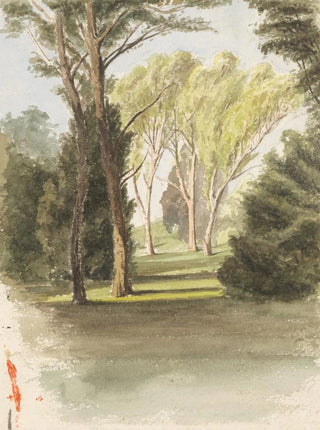Art print | Trees in a park - Ladislav Mednyánszky


View from behind

Frame (optional)
In a world where nature and art meet harmoniously, the artwork "Trees in a Park" by Ladislav Mednyánszky stands as a true ode to the beauty of landscapes. This painting, imbued with serenity, invites the viewer on a contemplative walk through a park where light plays with the foliage. The depicted scene evokes a peaceful atmosphere, where each tree seems to tell a story, and every shadow hints at a secret. Immersing oneself in this piece reveals not only a landscape but also a suspended moment in time, an invitation to escape.
Style and uniqueness of the artwork
Mednyánszky's style is characterized by an impressive mastery of nuances and textures. In "Trees in a Park," he employs a delicate color palette that reflects the variations of light throughout the hours. The deep greens of the foliage contrast with the lighter shades of the sky, creating an atmosphere of harmony and tranquility. The artist's technique, often associated with the Impressionist movement, manifests here through fluid and expressive brushstrokes, giving each element of the painting a palpable vitality. The composition, meanwhile, is carefully balanced, allowing the viewer's gaze to wander into the depth of the park while remaining anchored in the beauty of the details. This blend of realism and poetry makes this artwork a true masterpiece, capable of captivating the soul of anyone who gazes upon it.
The artist and his influence
Ladislav Mednyánszky is an emblematic figure of Hungarian art, whose artistic journey is marked by an unceasing quest for natural beauty. Born in 1852, he established himself as a landscape painter, influenced by the great masters of his time while developing his own artistic language. His work is often tinged with melancholy, reflecting his sensitivity to the fleeting nature of life. Mednyánszky also traveled across Europe, which allowed him to incorporate various influences into his work. His unique approach to light and space has left an indelible mark.

Matte finish

View from behind

Frame (optional)
In a world where nature and art meet harmoniously, the artwork "Trees in a Park" by Ladislav Mednyánszky stands as a true ode to the beauty of landscapes. This painting, imbued with serenity, invites the viewer on a contemplative walk through a park where light plays with the foliage. The depicted scene evokes a peaceful atmosphere, where each tree seems to tell a story, and every shadow hints at a secret. Immersing oneself in this piece reveals not only a landscape but also a suspended moment in time, an invitation to escape.
Style and uniqueness of the artwork
Mednyánszky's style is characterized by an impressive mastery of nuances and textures. In "Trees in a Park," he employs a delicate color palette that reflects the variations of light throughout the hours. The deep greens of the foliage contrast with the lighter shades of the sky, creating an atmosphere of harmony and tranquility. The artist's technique, often associated with the Impressionist movement, manifests here through fluid and expressive brushstrokes, giving each element of the painting a palpable vitality. The composition, meanwhile, is carefully balanced, allowing the viewer's gaze to wander into the depth of the park while remaining anchored in the beauty of the details. This blend of realism and poetry makes this artwork a true masterpiece, capable of captivating the soul of anyone who gazes upon it.
The artist and his influence
Ladislav Mednyánszky is an emblematic figure of Hungarian art, whose artistic journey is marked by an unceasing quest for natural beauty. Born in 1852, he established himself as a landscape painter, influenced by the great masters of his time while developing his own artistic language. His work is often tinged with melancholy, reflecting his sensitivity to the fleeting nature of life. Mednyánszky also traveled across Europe, which allowed him to incorporate various influences into his work. His unique approach to light and space has left an indelible mark.






